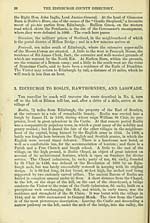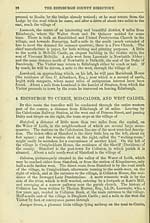Download files
Complete book:
Individual page:
Thumbnail gallery: Grid view | List view

COACH AND RAILWAY ROUTES. 27
footpath to the left conducts along an open meadow, through turnstiles, to the
woods of Roslin ; on emerging from which by a door in an old wall, the Visitor
enters the woods of
Hawthornden, the romantic residence of Lady Drummond, and of her
distinguished ancestor, William Drummond, the poet (1585-1649), where he
was visited by Ben Jonson in the winter of 1618-19. The pathway along
which the Visitor proceeds is on the left or west bank of the Esk, a lovely
though somewhat rugged and lonely walk, now open to the public by legal
decision, after an unsuccessful attempt to close it. The private grounds and
mansion of Hawthornden are on the other or east side of the river, half-a-mile
from the entrance to the woods, connected by a bridge, to which, however, no
access can be had by strangers from the public road ; x but any disappoint-
ment on this account is compensated by the circumstance that an excellent
view of the house, which stands on a cliff rising almost perpendicularly from
the bed of the river, is obtained from the public as well as the private side.
The path, which takes a winding course through the recesses of the wood,
conducts the Visitor, a short distance from the house, through a pleasant, open
meadow by the river side ; thence through a wooden stile, to the. rising grounds
which overlook the paper-mills at Springfield and Polton in the valley beneath.
Descending this hill to the left, past two low-roofed cottages, a footpath to the
right leads to Polton Station (for Lasswade and Edinburgh), and the road on
the left leads to the village of Loanhead, six miles from Edinburgh, and about
half-a-mile to the north of Springfield. The Visitor may either take this road
to Loanhead, and, by driving fully a mile east, reach Lasswade, or he may
proceed to Lasswade on foot, nearly the whole way, along the banks of the Esk
— the preferable route to one acquainted with the locality. Should he, however,
prefer to see more of Hawthornden before leaving the neighbourhood, he will
cross the river on the Loanhead road at Springfield to the right, retrace, as it
were, his steps along the road south of the Esk till he arrives at the Lodge, on
his right, the entrance to Hawthornden, by which admittance to the grounds is
gained on payment of Is. each person. [We may here mention that the most
direct route from Edinburgh is by train to Hawthornden, the Lodge being
only a few minutes' walk from the station.] In the well-kept grounds are
shown several subterranean caves, St Matthew's Well, the ruins of an old
tower, and a seat called the Cypress-grove, where the poet is supposed to have
sat while writing his poems. The caves, which are hewn out of the solid rock,
are well worthy of a visit. They are called the Caves of King Robert the
Bruce, and are so low that they can only be explored in a stooping posture.
At one end, on a table, are shown the Bruce's sword, and the desk from which
John Knox preached. On the right is Bruce's bed-room, a sort of circular
chamber, lighted and aired by a narrow port-hole to the river ; and opposite
the bed-room is the library, the most curious of all the apartments, in which
are no fewer than 170 shelves, in five tiers, cut out of the solid rock. The
Visitor may leave the grounds by the path up the south bank of the Esk, and
1 The low and romantic walk by the river side past the bridge, formerly open to the
pnblic, has been closed since the above decision, which applied to the high road only ;
and strangers who descend by this footpath must return to the road which conducts
to the higher ridge of the glen. The prohibitory ticket at the approach might have
some chance of being attended to were all the obsolete prohibitory notices removed,
as they deface the trees as well as perplex strangers.
footpath to the left conducts along an open meadow, through turnstiles, to the
woods of Roslin ; on emerging from which by a door in an old wall, the Visitor
enters the woods of
Hawthornden, the romantic residence of Lady Drummond, and of her
distinguished ancestor, William Drummond, the poet (1585-1649), where he
was visited by Ben Jonson in the winter of 1618-19. The pathway along
which the Visitor proceeds is on the left or west bank of the Esk, a lovely
though somewhat rugged and lonely walk, now open to the public by legal
decision, after an unsuccessful attempt to close it. The private grounds and
mansion of Hawthornden are on the other or east side of the river, half-a-mile
from the entrance to the woods, connected by a bridge, to which, however, no
access can be had by strangers from the public road ; x but any disappoint-
ment on this account is compensated by the circumstance that an excellent
view of the house, which stands on a cliff rising almost perpendicularly from
the bed of the river, is obtained from the public as well as the private side.
The path, which takes a winding course through the recesses of the wood,
conducts the Visitor, a short distance from the house, through a pleasant, open
meadow by the river side ; thence through a wooden stile, to the. rising grounds
which overlook the paper-mills at Springfield and Polton in the valley beneath.
Descending this hill to the left, past two low-roofed cottages, a footpath to the
right leads to Polton Station (for Lasswade and Edinburgh), and the road on
the left leads to the village of Loanhead, six miles from Edinburgh, and about
half-a-mile to the north of Springfield. The Visitor may either take this road
to Loanhead, and, by driving fully a mile east, reach Lasswade, or he may
proceed to Lasswade on foot, nearly the whole way, along the banks of the Esk
— the preferable route to one acquainted with the locality. Should he, however,
prefer to see more of Hawthornden before leaving the neighbourhood, he will
cross the river on the Loanhead road at Springfield to the right, retrace, as it
were, his steps along the road south of the Esk till he arrives at the Lodge, on
his right, the entrance to Hawthornden, by which admittance to the grounds is
gained on payment of Is. each person. [We may here mention that the most
direct route from Edinburgh is by train to Hawthornden, the Lodge being
only a few minutes' walk from the station.] In the well-kept grounds are
shown several subterranean caves, St Matthew's Well, the ruins of an old
tower, and a seat called the Cypress-grove, where the poet is supposed to have
sat while writing his poems. The caves, which are hewn out of the solid rock,
are well worthy of a visit. They are called the Caves of King Robert the
Bruce, and are so low that they can only be explored in a stooping posture.
At one end, on a table, are shown the Bruce's sword, and the desk from which
John Knox preached. On the right is Bruce's bed-room, a sort of circular
chamber, lighted and aired by a narrow port-hole to the river ; and opposite
the bed-room is the library, the most curious of all the apartments, in which
are no fewer than 170 shelves, in five tiers, cut out of the solid rock. The
Visitor may leave the grounds by the path up the south bank of the Esk, and
1 The low and romantic walk by the river side past the bridge, formerly open to the
pnblic, has been closed since the above decision, which applied to the high road only ;
and strangers who descend by this footpath must return to the road which conducts
to the higher ridge of the glen. The prohibitory ticket at the approach might have
some chance of being attended to were all the obsolete prohibitory notices removed,
as they deface the trees as well as perplex strangers.
Set display mode to: Large image | Transcription
Images and transcriptions on this page, including medium image downloads, may be used under the Creative Commons Attribution 4.0 International Licence unless otherwise stated. ![]()
| Scottish Post Office Directories > Counties > Midlothian (Edinburghshire) > Edinburgh county directory > (33) |
|---|
| Permanent URL | https://digital.nls.uk/85990531 |
|---|
| Description | Directories of individual Scottish counties or parts of counties. |
|---|
| Description | Around 700 Scottish directories published annually by the Post Office or private publishers between 1773 and 1911. Most of Scotland covered, with a focus on Edinburgh, Glasgow, Dundee and Aberdeen. Most volumes include a general directory (A-Z by surname), street directory (A-Z by street) and trade directory (A-Z by trade). |
|---|


